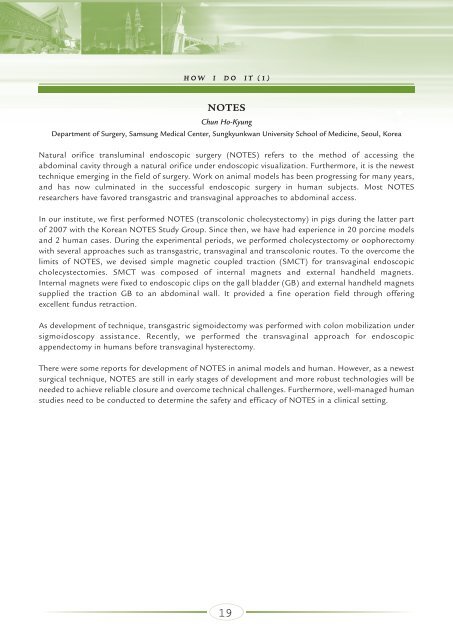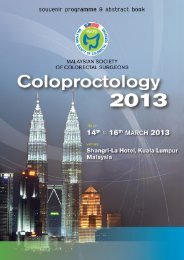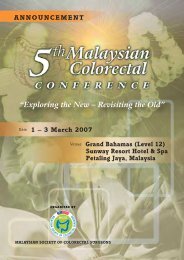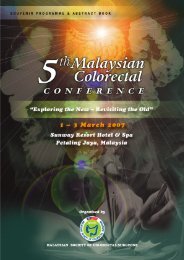here - Malaysian Society of Colorectal Surgeons
here - Malaysian Society of Colorectal Surgeons
here - Malaysian Society of Colorectal Surgeons
You also want an ePaper? Increase the reach of your titles
YUMPU automatically turns print PDFs into web optimized ePapers that Google loves.
H O W I D O I T ( 1 )NOTESChun Ho-KyungDepartment <strong>of</strong> Surgery, Samsung Medical Center, Sungkyunkwan University School <strong>of</strong> Medicine, Seoul, KoreaNatural orifice transluminal endoscopic surgery (NOTES) refers to the method <strong>of</strong> accessing theabdominal cavity through a natural orifice under endoscopic visualization. Furthermore, it is the newesttechnique emerging in the field <strong>of</strong> surgery. Work on animal models has been progressing for many years,and has now culminated in the successful endoscopic surgery in human subjects. Most NOTESresearchers have favored transgastric and transvaginal approaches to abdominal access.In our institute, we first performed NOTES (transcolonic cholecystectomy) in pigs during the latter part<strong>of</strong> 2007 with the Korean NOTES Study Group. Since then, we have had experience in 20 porcine modelsand 2 human cases. During the experimental periods, we performed cholecystectomy or oophorectomywith several approaches such as transgastric, transvaginal and transcolonic routes. To the overcome thelimits <strong>of</strong> NOTES, we devised simple magnetic coupled traction (SMCT) for transvaginal endoscopiccholecystectomies. SMCT was composed <strong>of</strong> internal magnets and external handheld magnets.Internal magnets were fixed to endoscopic clips on the gall bladder (GB) and external handheld magnetssupplied the traction GB to an abdominal wall. It provided a fine operation field through <strong>of</strong>feringexcellent fundus retraction.As development <strong>of</strong> technique, transgastric sigmoidectomy was performed with colon mobilization undersigmoidoscopy assistance. Recently, we performed the transvaginal approach for endoscopicappendectomy in humans before transvaginal hysterectomy.T<strong>here</strong> were some reports for development <strong>of</strong> NOTES in animal models and human. However, as a newestsurgical technique, NOTES are still in early stages <strong>of</strong> development and more robust technologies will beneeded to achieve reliable closure and overcome technical challenges. Furthermore, well-managed humanstudies need to be conducted to determine the safety and efficacy <strong>of</strong> NOTES in a clinical setting.19










